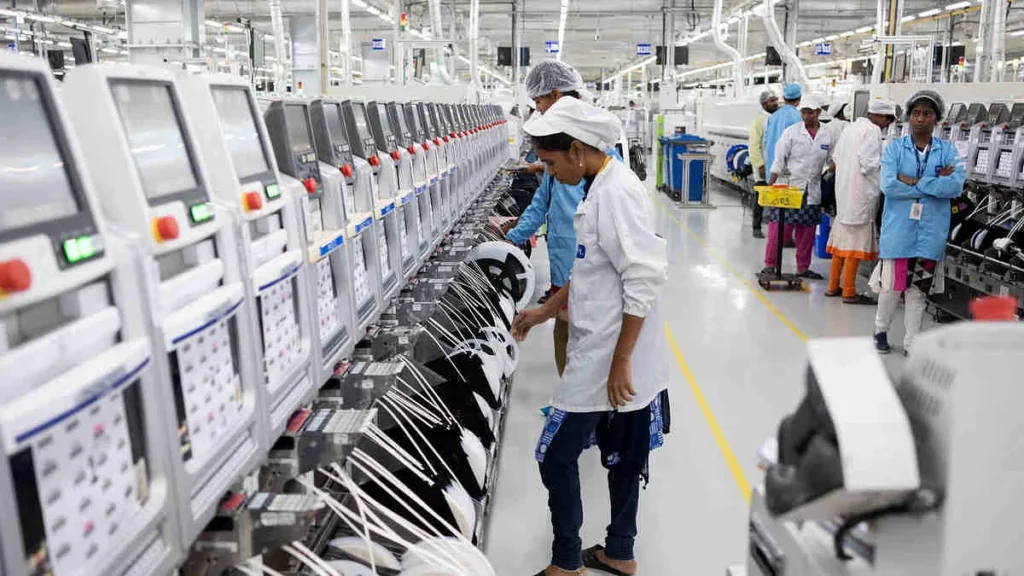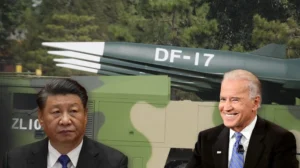Source : Firstpost
Shifting the spotlight on India, Apple finally opened the doors for Indian consumers with its first retail stores in the financial and national capitals. But Apple CEO Tim Cook’s visit in April also brought a lot of cheer because of plans to diversify the supply chain away from China. It took a pandemic and geopolitical unrest for the Cupertino-based company to realise the need to ramp up production in other parts of the world. Apple dominates the luxury phone market in India, holding 63 percent of the market share in this category. But it holds only 6 percent of the market share in the overall smartphone segment.
India’s dream of becoming the ‘New Factory of the World’ gets a boost in 2023

Apple and its suppliers aim to build more than 50 million iPhones in India annually within the next two to three years. It’s biggest supplier, Foxconn, is already expanding manufacturing and spearheading the production shift for Apple by setting up more plants in different parts of India. On December 12, the Taiwan-based tech giant received approval from the Karnataka government for an additional investment of Rs 13,911 crore in its upcoming facility in Bengaluru Rural District. It had already received approval to invest Rs 8,000 crore earlier this year.
In the meantime, work is underway on Foxconn’s manufacturing facility, located on 300 acres of land near Kempegowda International Airport in Bengaluru. In May, Hon Hai Precision Industry acquired the land for Rs 300 crore. Production at this plant will commence in April 2024. Recognised for assembling around 70 percent of global iPhones and known as the largest contract manufacturer globally, Foxconn’s manufacturing targets for the plant include one lakh units of iPhones by December 2025, 50 lakh units by December 2026, one crore by December 2027, and two crores by December 2028.
Recently, the Tata Group became the first Indian company to make Apple iPhones after it acquired a full stake in Wistron. The company is reportedly working towards establishing one of India’s largest iPhone assembly plants in Tamil Nadu, and it is expected to exceed the scale of the acquired Wistron plant in Karnataka, which employs over 10,000 people.
Launched in 2020, production-linked incentives (PLIs) have incentivised key suppliers of Apple, such as Foxconn and Pegatron, to intensify their presence in India. This has led to a significant increase in iPhone assembly in the country, surpassing $7 billion in the previous fiscal year and capturing approximately 7 percent of the device’s global production share.
A push for semiconductor manufacturing
India’s large population and maturing economy have witnessed a notable surge in electronics consumption in recent years. The Indian semiconductor market is expected to reach $55 billion by 2026, more than 60 percent of which will be driven by smartphones and wearables, automotive components, computing, and data storage. The majority of the demand in the Indian semiconductor market is currently met by imports. In order to reduce this dependency, the Government of India has approved the Semicon India Programme with an initial financial outlay of Rs 76,000 crore for the development of a sustainable semiconductor and display ecosystem in India.
During Prime Minister Narendra Modi’s US visit in June this year, amid the multiple pacts signed between both countries, the joint development of technologies in the area of semiconductors was one of the highlights. US President Joe Biden and Modi signed the Memorandum of Understanding (MoU) on Semiconductor Supply Chain and Innovation Partnership with the objective of coordinating semiconductor incentive programmes in India and the US.
Subsequently, US chipmaker Micron Technology announced that it would invest up to $825 million to build a semiconductor assembly and test facility in Gujarat, taking advantage of the fiscal support being extended by the Indian government. This was followed by investment announcements from Applied Materials and Advanced Micro Devices (AMD).
Foxconn has also recently submitted an application to establish a semiconductor fabrication unit in India. This comes after its exit from a joint venture with the Vedanta Group, which had plans to set up a chip plant in Gujarat with an investment of around Rs 1.5 lakh crore. Despite this, Foxconn remains bullish.
Reportedly, even Tata Group is planning to set up a semiconductor processing plant in Assam with an investment of about Rs 40,000 crore, according to Chief Minister Himanta Biswa Sarma. Another Indian conglomerate, Murugappa Group, has announced getting into semiconductor assembly and testing. The Chennai-based company would invest $791 million over five years in the business. The company has filed an application with the Union Ministry of Electronics and Information Technology (MeiTY) seeking subsidies for an outsourced semiconductor assembly and testing (OSAT) facility in India.
Next decade
According to experts, India cannot solely rely on global investments and it is critical to look at domestic sources of financing and leverage the multiplier effect of money. Nilaya Varma, co-founder of Primus Partners, a management consulting firm, points out that global partnerships are necessary for India to recover lost time and expertise, but it’s important to look at the structures of doing it so that there is no over-reliance on foreign investments. “Manufacturing is surely important, and more so because India clearly missed this leg of the transition when moving up the food chain from an agriculture-driven economy to a service-driven economy directly. However, manufacturing needs to be looked at from the perspective of creating jobs, creating self-reliance in critical areas, and driving the same by leveraging domestic investments,” says Varma adding that it is therefore important to focus on the smaller companies and MSMEs because, through them, the growth will be driven multiple times more across the above areas. “This decade is going to be critical for the coming few decades, and hence investments in more value-added manufacturing are more important than just run-of-the-mill build-to-print work.”
What is coming next is going to be multiple times more evolutionary than what was there a decade ago. One could also go ahead and suggest that Moore’s law (which says that the number of transistors in an integrated circuit (IC) doubles about every two years) is possibly being redefined. Technology is evolving at a much faster rate. What is “in” today may as well be “out” in even a year’s time, adds Varma.







